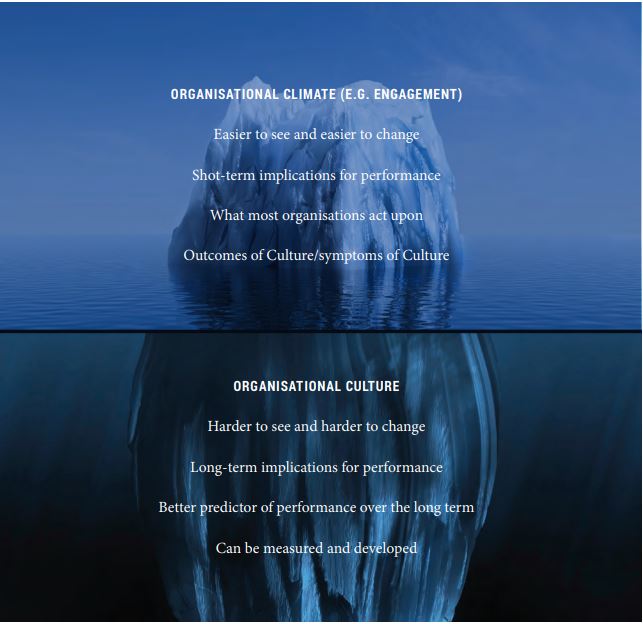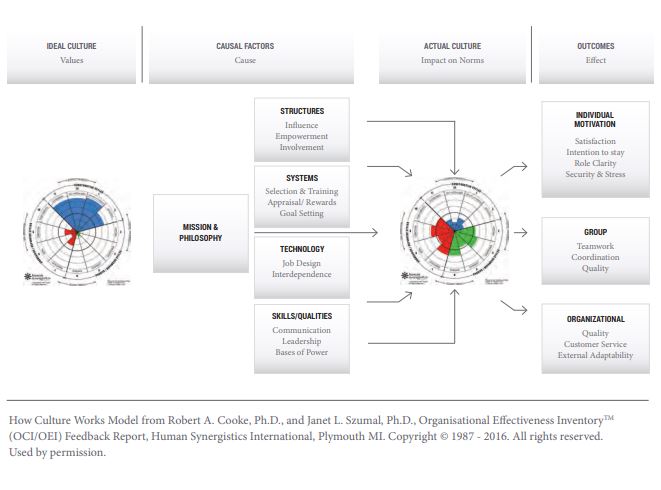The difference between Organisational Culture and Engagement
In the ever-evolving landscape of modern organisations, two terms often come up in discussions about workplace success: culture and engagement. While they might seem interchangeable at first glance, understanding their unique differences can unlock a new level of organisational performance. Culture and climate (engagement) present a systematic way of measuring and changing employee experience within organisations in Australia and New Zealand.
Organisational culture and climate, along with employee engagement, are distinct concepts that are often mistakenly conflated. While they are interrelated, it is important to recognise that they are also separate entities.
Culture shapes the environment where employees operate, while engagement measures how connected and motivated they feel within that space.
An organisation can have high employee engagement with a poor culture but an organisation with a great culture is bound to have high employee engagement.
Culture is not engagement
Engagement does not cause Culture – in fact it’s the other way around, engagement is a symptom of culture, so the key to improving engagement lies in improving culture.
While well-defined culture might foster compliance or adherence to norms, it doesn’t guarantee enthusiasm or passion for one’s role. This distinction highlights why organisations need tailored strategies for improving both areas effectively rather than assuming they will naturally sit side-by-side.
Understanding the difference between culture and climate (engagement)
Culture is airborne, and socially transmitted, both explicitly and implicitly – it’s what we are taught and what we observe. Culture refers to the shared values, beliefs and practices that define how a group or business operates. A social phenomenon, culture is the silent underlying framework that dictates interactions among its employees.
Engagement, on the other hand, is more concerned with how emotionally invested individuals are in their work and their company. A highly engaged employee feels connected to their role and is motivated to contribute positively. Whilst many factors can influence engagement including job design, autonomy, team support and leadership, engagement is often a by-product of an organisational culture. Therefore, ensuring good cultural health often and distinctly affects engagement.
The primary distinction lies in the fact that Organisational Climate (engagement) deals with perceptions and emotions, while Organisational Culture focuses on behaviour.
Organisational Climate is made up of two separate but related variables:
- Perceptions – what organisational members see going on and the meaning they attach to this, and
- Attitudes – how organisational members feel about what they see going on and how they feel about their
organisation, their managers and their jobs.
Engagement is an outcome of culture
When leaders prioritise open communication and shared values, they cultivate trust among team members, which in turn sparks creativity and innovation. In such an atmosphere, people are more likely to invest their time and energy into their roles because they genuinely care about the collective mission. So much more than just policies or procedures, organisational culture shapes how individuals interact daily—and ultimately drives higher levels of engagement across the board!
Recognising this relationship helps leaders shape desirable outcomes through intentional cultural development efforts.
Like all measures of organisational Climate, engagement is a reasonable predictor of short-term performance. Long-term performance is better predicted by the organisation’s culture.
The relationship between Culture and Climate – Metaphor: The Iceberg
At Human Synergistics we often use the metaphor of an iceberg to describe the relationship between culture and climate. In the realm of organisational life, there are two important components that can be compared to this metaphor. The first is climate, which is visible and readily comprehensible on the surface. The second is culture, which can be likened to the hidden portion of an iceberg submerged underwater. Although not easily observable, culture makes up 90% of the iceberg’s mass and greatly influences its response to ocean currents.
Integrating Culture and Climate
After researching organisational Culture and organisational Climate for over 30 years, Dr Robert A. Cooke designed a model to integrate both, and show how each influences the other. He calls it his “How Culture Works model”. In his model he shows the causal relationships between Culture and Climate. He clearly distinguishes between the perceptions (how we do things around here) and feelings (how we feel about being around here) aspects of Climate, and illustrates how Culture (how we are expected to behave around here) moderates the impact of perceptions on feelings and attitudes.
How Culture works
Measuring and Aligning Culture and Climate
Based on Dr Cooke’s How Culture Works Model, integrating Climate and Culture, we can:
- Examine the desired or ‘ideal’ organisational culture of senior executives, which embodies the organisation’s values and promotes high performance through expected behaviours,
- Analyse how organisational members perceive the consistency of their organisation’s structures, practices, and systems with its ideal culture (causal factors). These measures of climate type provide insight into how effectively the organisation is cultivating an environment conducive to achieving high performance.
- Observe the actual operating culture that arises from the implementation of these organisational components. This gives insight into the behaviours that are being produced by these structures, practices and systems, and
- Examine the impact of this culture on individuals (e.g. engagement), groups (e.g. teamwork), and the organisation as a whole (e.g. adaptability). These climate metrics reveal performance results.
This allows actions to be focused on what truly makes a difference and produces tangible enhancements, whether it be financial metrics for businesses or outcome-based measures for governmental or non-profit organisations.
By focusing only on engagement and organisational Climate data, we are only exploring what is happening, not why it is happening.
The Impact of External and Internal Changes on Culture and Climate Survey Results
Common questions asked by clients:
• When is the right time to do a survey?
• We’ve just restructured, perhaps we should delay the survey for a while?
• Does an unexpected drop or upswing in performance impact on our survey results?
• We’re in the midst of tough negotiations around our new EBA, will this affect our survey results?
• We’ve just offshored some of our administrative work, will this impact on our survey results?
Would you like to know more?
If you’d like more information on how Human Synergistics can work with you in 2025 on both culture and engagement please email us on info@human-snergistics.com.au or call us on 02 9247 6310 for a free and confidential chat .
For more information on the difference between culture and engagement download our whitepaper here


